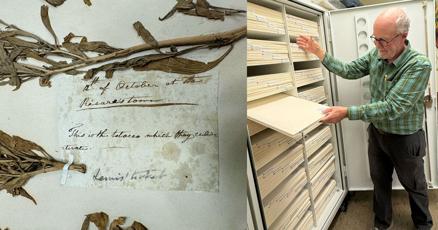[[{“value”:”
When President Thomas Jefferson sent Meriwether Lewis and William Clark on the original American road trip in 1804, there weren’t many roads, so they took boats. Up the Missouri River and into the great unknown.
One of their tasks was to collect and catalog detailed information about the natural world as they made their way westward.
When the expedition returned in 1806, the American explorers brought with them a collection of over 200 plant samples that Lewis meticulously cataloged and preserved.
The Corps of Discovery expedition ended in 1806, but for this collection of plants, the journey continued on. Through a series of accidents, oversights and plain dumb luck, these 222 plant samples ended up on the other side of the Atlantic for many years and were almost destroyed.
Now the collection, known as the Lewis and Clark Herbarium, is housed at the Academy of Natural Sciences at Drexel University in Philadelphia.
How it got there and why it took nearly 80 years is the topic of today’s episode.
We listen to Eric Hurlock’s interview with Dr. Rick McCourt, botanist at the Academy of Natural Sciences and curator of the Herbarium.
What You’ll Learn
• How Lewis & Clark’s plant samples survived over two centuries of mishaps.
• The role of Philadelphia as a hub of botanical science in early America.
• Details on plant preservation techniques from the early 1800s.
• The intriguing story of wild tobacco rediscovered after being presumed extinct.
• Future research potential from ancient DNA preserved in plant specimens.
Learn More:
Academy of Natural Sciences at Drexel University
See Photos of the Herbarium:
Thanks to our Sponsors
Americhanvre Cast-Hemp Ereasy Training May 7-10
Music by Tin Bird Shadow
”}]] Today’s guest botanist Rick McCourt tells the story of Lewis and Clark’s collection of plant samples that went on a wild journey after the Corps of Discovery expedition came to Read More


